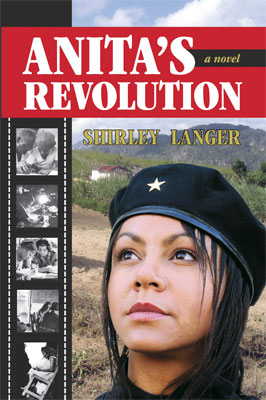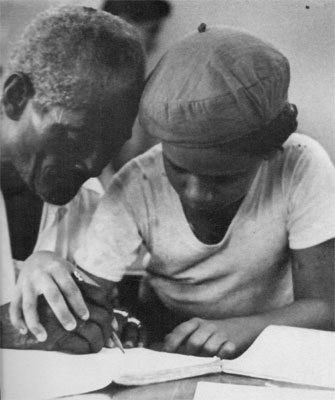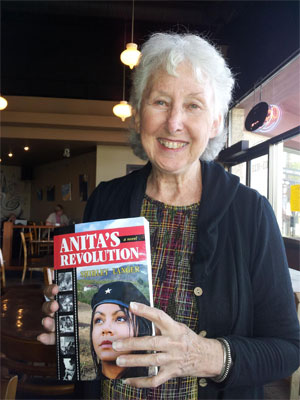A Unique Chapter From Cuba’s History
by Shirley Langer *
 HAVANA TIMES — 2011 marked the 50th anniversary of Cuba’s successful national literacy campaign which almost eradicated wide-spread illiteracy in less than a year.
HAVANA TIMES — 2011 marked the 50th anniversary of Cuba’s successful national literacy campaign which almost eradicated wide-spread illiteracy in less than a year.
When Fidel Castro came to power in 1959, Cuba’s population was six million people. Of those, 25% were totally illiterate, one million of whom were adults.
The new government planned to undertake sweeping changes to reform society, but how could the government inform and involve people in these changes if 25% could not read a billboard, an information pamphlet, fill out the most simple form or even sign their name?
When reporters asked Fidel Castro what the most important things facing the new revolutionary government were, he is reputed to have said: The first most important thing is education. The second most important thing is education, and the third is also education.
Speaking before the General Assembly of the United Nations in September 1960, Castro made an audacious announcement. By the end of 1961, he said, Cuba would be “un territorio libre de analfabetismo”, a territory free from illiteracy.
Upon his return to Cuba, he told Minister of Education, Armando Hart, to make it happen. With few resources, the campaign got underway in May of 1961, delayed by the Bay of Pigs invasion. When the campaign ended seven months later, marked by an event held in Havana’s gigantic civic square attended by a million people, illiteracy among adults had been reduced from 25% to 3.9%. On December 22, 1961, a flag was raised proclaiming Cuba to be Un Territorio Libre de Analfabetismo.
A UNESCO team sent to Cuba in 1964 to study and evaluate the methodology and results of theliteracy campaign concluded that it was the most successful literacy campaign ever undertaken.
 Perhaps the most amazing aspect of the campaign is that the majority of the teaching was accomplished by 100,000 (mostly) teenagers who responded to the national call for youth volunteers. Called “brigadistas” – members of the brigade – those young people left the comfort of their homes to go and live with illiterate learners wherever and however they lived.
Perhaps the most amazing aspect of the campaign is that the majority of the teaching was accomplished by 100,000 (mostly) teenagers who responded to the national call for youth volunteers. Called “brigadistas” – members of the brigade – those young people left the comfort of their homes to go and live with illiterate learners wherever and however they lived.
In many cases, “wherever” was in rural bohíos, thatch-roofed huts with hardened-earth floors. For seven months, those whose assignments located them in the countryside would live without running water, electricity or toilets – in general, in primitive conditions.
Each brigadista was given two sets of army-type uniforms, a beret, a pair of army-style boots, two pairs of socks, a warm blanket, a sack-cloth hammock and a lantern imported from China so they could teach where light wasn’t available.
Most received a two-week or less crash teaching course at Varadero Beach resort, which for that time was turned into a massive teaching and dormitory facility. The teaching resources the brigadistas carried to their assignments were flimsy: a teacher’s manual and guide and work books for the learners.
What the brigadistas lacked in resources, they made up for with youthful health and vigour, nationalistic zeal to do something important for their country, and the determination to make Fidel Castro’s words reality, that is, to stamp out illiteracy.
Toward the end of that summer of 1961, campaign organizers saw that they would have to get more human resources into the campaign if it was to succeed by year’s end. Workers of all kinds were released from their jobs to spread throughout the country to teach. Urban dwellers were asked to volunteer to teach in their neighbourhoods.

Regular schools would not re-open in September, enabling professional teachers to tutor where needed. The motto became: For each one who needs to learn, someone to teach. The country became one gigantic school.
At the end of a scant seven months of campaign effort which involved the whole nation, on December 22, 1961 Cuba celebrated its goal ending nearly five hundred years of ignorance and marginalization. The oldest newly-literate learner, a woman 106 years old, was born a slave.
What started in 1961 continued then and continues today to guarantee universal education. Graduates may attend any of Cuba’s colleges at no cost, and according to UNESCO, one of every fifteen Cubans holds a university degree.
UNESCO has stated that the Cuban struggle to eradicate illiteracy and to bring all students and adults to an effective functional level has proven itself not just a one-time tour de force, but rather a success story that has no end.
The success of the Cuban campaign changed the course of Cuba’s history and made it a sought-after program. Today Cuba helps other countries via a modernized audio-visual literacy teaching program called Yo sí puedo! Yes I can!
Yo sí puedo! has been conducted extensively in Venezuela, Nicaragua, Timor Leste (formerly East Timor) and Tanzania. Recently, the Squamish First Nation in British Columbia Canada has begun the program.
—–
(*) Shirley Langer lived and worked in Cuba for almost five years in the mid 1960s. She is the author of the recently published book, “Anita’s Revolution”, a historical fiction novel chronicling the Cuban literacy campaign of 1961. The novel is available as an e-book from online bookstores Kindle, Lulu and Smashwords. The book in print form may be purchased online from CreateSpace, or by contacting Shirley directly by e-mail: [email protected].
To learn more about Shirley Langer and Anita’s Revolution, visit the website: anitasrevolution.com






You can actually find all of the authors in Cuba, just go to plaza de armas and look at the bookstands. But I would bet that most haven been in Cuba for a long time, if ever. The late Carlos Franqui was openly in favor of an invasion in Cuba in order to achieve a regime change. The problem is that not few ‘writers’ became politically very active. You probably would not find any state in this world that sponsors writers in their public editorial houses that openly call for a regime change. Remember McCarthy and what they did to writers and artists in the US? Fortunately we live in different times now, here and there.
Most other great Cuban writers, like Lezama Lima have long been rehabilitated and are being published, just look at the publishing lists and book fair programs.
But more importantly, the article is on the process that made one fourth of the population literate and catapulted Cuba into a modern, literate nation. Today, according to the UN there are still more than 700 million people illiterate. It is revealing that most people here comment on the few exemptions rather than the great empowerment that this process had meant, despite its shortcomings and subsequent limitations
Brian, one reason Cuba fails to receive the ‘positive press’ regarding what might be considered the good things they do is because western media is accustomed to conducting independent investigations of press releases before they are authorized to go to print. That is to say, that it is probable that an Australian reporter contacted official Cuban sources to confirm the Yo Se Puedo program activities only to be met with a “no further comment” response. Questions like how much will the Cuban government spend, how long will it take or how successful is this program elsewhere are questions routinely ignored by Cuban officials because of paranoia or distrust.
There is not much publicity around the fact that Cuba has initiated a Yo Se Puedo program for Aborigines in Western New South Wales. Australia would prefer that Cuba gets no positive Press for the good things they do around the world. It is time Australia embraced Cuba and ignored the US sanctions
“When reporters asked Fidel Castro what the most important things facing
the new revolutionary government were, he is reputed to have said: The
first most important thing is education. The second most important thing
is education, and the third is also education.”
Is this a legend? Seeing how much education was given a priority, it wouldn’t be surprise to anyone if this was not.
The ‘revolutionary’ (as the assassins and torturers like to call themselves) military gorillas of ’64 literally thrashed public education and since then no government – no even comrade Lula’s – was able to repair the damage. In a survey involving 40 countries, mine was placed second worst in terms of education.
The contrast couldn’t be bigger.
Here is a short list, just a few of the many Cuban writers who were persecuted by the Castro regime. Ironically all of these writers listed below were initially supportive of the revolution and some of them even held responsible positions in the government, before falling afoul of officialdom.
Reinaldo Arenas – imprisoned & exiled
Guillermo Cabrera Infante – exiled
Antonio Benítez Rojo – exiled
Norberto Fuentes – exiled
Heberto Padilla – imprisoned & exiled
Carlos Franqui – imprisoned & exiled
Virgilio Piñera – imprisoned
Tell me how many of these writers books are still available in Cuba?
Michael, with all due respect, the censorship in Cuba, as censorship goes in general, is conspicuous not by what books are available to be purchased but by the books NOT available for purchase. You did NOT see anything written by any exiled and banned Cuban writer (or any other for that matter) that was critical of the regime. As Fidel once said, “inside the revolution everything, outside the revolution nothing”.
That’s a funny thing to write on the day the regime sent the Cuban writer Angel Santiesteban to prison.
Reporters without borders ranked Cuba the 10th worst offender of press freedom in the world.
Maybe it’s not the bad old days, but it sure isn’t very much better.
The bookstores I visited during my recent two-month visit this (Sept. & Oct.), contained a plethora of novels, poetry and non-fiction of (almost) every political flavor and artistic tendency. I bought a stack of books in Spanish and, as I am reading through them, I can discern no particular political “line.” Likewise the meetings of the Uneac I attended in Sancti Spiritus, and the two other poetry penas I attended in that city. Despite the bad old days, when the doctrinaire party line prevailed in literature (especially in the 1970’s and 1980’s, but never even completely during those times), now all the stops seem to be pulled out–or are being pulled out daily, much like they were in the Paris of the 1780’s, just before the end of the ancien regime. At least in part this heritage of literature is a consequences of the 1961 campaign to eradicate illiteracy.
Iroel Sanchez, the former head of the Cuban Book Institute is renowned among Cuban writers for the power he once wielded in deciding what Cuban writers would be published and what writers wouldn’t. He blacklisted many outstanding Cuban writers based on political-correctness as opposed to literary value. This is evidenced in every state-run bookstore in Cuba overrun with every manner of Che and Fidel publications. As a result of government censorship, despite all the merited kudos earned by the Cuban literacy program, Cubans, because of limited internet access and government controls are decidedly less well-read.
The elimination of literacy was a great achievement, as far as it went.
However, it is tragic that the Cuban people still do not enjoy freedom of expression, that writers are imprisoned for their work and that the books of many great Cuban writers are banned in their own country.